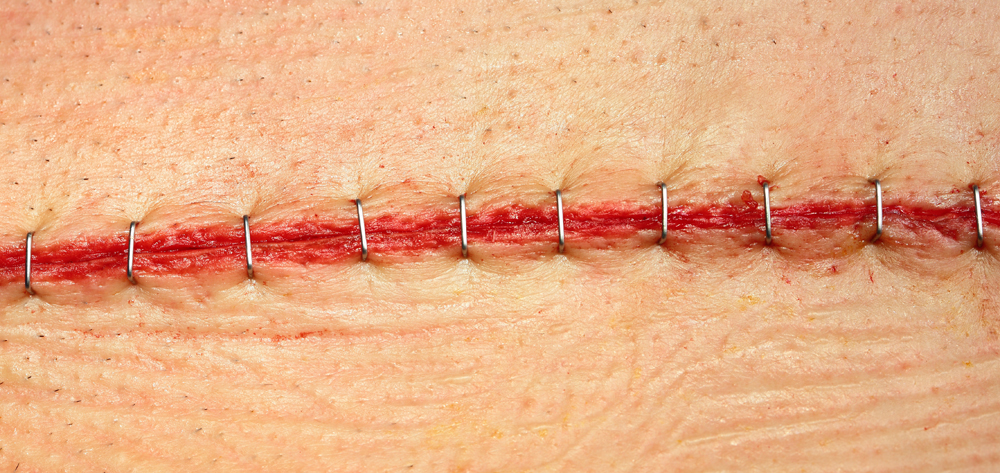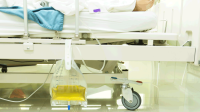With so much focus on dressing choices, it’s easy to forget the importance of wound cleansing. Cleaning a wound removes loose debris and planktonic (free-floating) bacteria, provides protection to promote an optimal environment for healing, and facilitates wound assessment by optimizing visualization of the wound. You should clean a wound every time you change a dressing, unless it’s contraindicated.
Here’s a review of how to choose and use a wound cleanser so you can see if your practice is up to date.
Choosing a wound cleanser
The ideal wound cleanser is hypoallergenic, nontoxic to viable tissue, readily available, cost effective, and stable. The wound cleanser should also:
- be effective in the presence of organic material, such as blood, slough, or necrotic tissue
- reduce the number of microorganisms that form on the surface of the wound
- have a delivery force less than 15 pounds per square inch.
Common wound cleansers
Below are common types of wound cleansers:
- Normal saline solution. Normal saline solution is the preferred cleansing agent because as an isotonic solution, it doesn’t interfere with the normal healing process. It’s also cost effective and available in many different formats, including unit dose, half liters, liters, and spray bottles.
- Commercial cleansers. Ingredients in commercial cleansers may include surfactants, wetting agents, moisturizers, and/or antimicrobials. Surfactants are agents that facilitate removal of wound contaminants. Each surfactant molecule has a hydrophilic (water-loving) head that is attracted to water molecules and a hydrophobic (water-hating) tail that repels water and simultaneously attaches itself to wound contaminants, oils, or grease. These opposing forces loosen the particles and suspend them in the water.
- Skin cleansers. Skin cleansers areformulated to remove fecal matter, so they should never be used on open wounds, as they tend to be stronger than a wound cleanser and toxic to wound tissues.
- Lactated Ringer’s solution. Lactated Ringer’s solution provides sodium, potassium, and calcium chloride to the wound, while safely cleaning it and avoiding damage to viable cells. Be careful when the solution is used for continuous irrigation or allowed to dwell inside body cavities; otherwise the solution could be absorbed into the bloodstream, leading to circulatory overload.
- Potable (drinkable) tap water. Potable tap water can be used if there is no other alternative. Check the quality of the water source. Advantages of tap water for wound cleansing are efficiency, cost effectiveness, and accessibility. However, use normal saline solution instead of water for wounds with exposed bone or tendon.
How to clean a wound
Before you start, make sure the cleansing solution is at room temperature or slighter warmer. It can take up to 40 minutes after cleaning for a wound to regain its original temperature, and up to 3 hours for miotic cell division and leukocytic activity to return to normal.
Once the solution is warm, wash your hands and put on gloves.
View a video on wound cleaning
Manual cleansing technique
For a linear wound or incision:
1. Pour irrigation solution into the irrigation tray. Moisten clean 4″×4″ gauze pads in the solution; squeeze out excess.
2. Gently wipe the wound from top to bottom in one motion, starting directly over the wound.
3. Discard the used gauze pad.
4. Using a new moistened 4″×4″ gauze pad, repeat cleaning, using a gentle downward stroke parallel to the incision.
5. Repeat steps, working outward from the incision in lines parallel to the incision.
6. Remember to use a new 4″×4″ gauze pad for each downward stroke.
7. If needed, dry the wound, following the same procedure as for cleaning, using dry gauze pads.
For an open wound:
1. Pour the irrigation solution into the irrigation tray. Moisten 4″×4″ gauze pads in the solution; squeeze out excess.
2. Gently clean the wound in a full or half circle, beginning in the center and working toward the outside.
3. Use a new 4″×4″ gauze pad for each circle.
4. Clean at least 1 inch beyond the end of the new dressing or 2 inches beyond the wound margins if you aren’t applying a dressing.
5. If needed, dry the wound, using the same procedure as for cleaning. Gently pat the wound dry, using dry gauze pads.
Spray cleansers
1. Spray cleansers may be applied directly to the wound or sprayed onto clean 4″×4″ gauze pads and then applied to the wound.
2. Check your organization’s policy for required personal protective equipment (PPE). Generally, wound irrigation
that involves squirting, spraying, or pressure release of fluid will require the use of PPE (such as gloves, gown, and mask with eye shield) to prevent exposure to debris and airborne microorganisms.
3. Protect the environment, equipment, and other supplies from contamination from spray aerosolization by covering or removing the supplies.
4. Hold the spray bottle approximately
1 inch from the wound bed. Aim the nozzle at the wound and squeeze the bottle, directing the stream of cleanser along the base and sides of the wound.
5. Blot up excess moisture with a clean gauze pad.
6. Dry the surrounding skin.
Cleaning with a saline bullet
1. Position the patient so that the cleansing solution will flow by gravity from the upper end of the wound to the lower end.
2. Twist off the top.
3. Position the container at any angle required to access the area to be moistened or cleaned.
4. Apply firm pressure to the container to obtain the desired flow rate.
5. Blot up excess moisture with a clean gauze pad.
6. Dry the surrounding skin.
After you have finished cleaning the wound, dispose of the waste in a trash bag; then remove and discard your gloves and any other PPE you used.
Selected references
European Pressure Ulcer Advisory Panel and National Pressure Ulcer Advisory Panel. Treatment of pressure ulcers: Quick reference guide. Washington, DC: National Pressure Ulcer Advisory Panel; 2009.
Hess CT (ed.). Clinical Guide to Wound Care. 7th ed. Philadelphia, PA: Lippincott Williams & Wilkins; 2012.
Kosier B. Fundamentals of Nursing: Concepts, Process, and Practice. 6th ed. Upper Saddle River, NJ: Prentice-Hall, Inc; 2000.
Ovington LG. Hanging wet-to-dry dressings out to dry. Adv Skin Wound Care. 2002;15(2):79-84.
Wound Source. Wound cleansers. http://www.woundsource.com/product-category/wound-cleansers/wound-cleansers. Accessed April 1, 2013.
Donna Sardina is Editor-in-Chief of Wound Care Advisor and cofounder of the Wound Care Education Institute in Plainfield, Illinois.
Editor’s note: This article appeared in the May issue of Wound Care Advisor, the official journal of the National Alliance of Wound Care and Ostomy. Access the journal at www.WoundCareAdvisor.com.


















